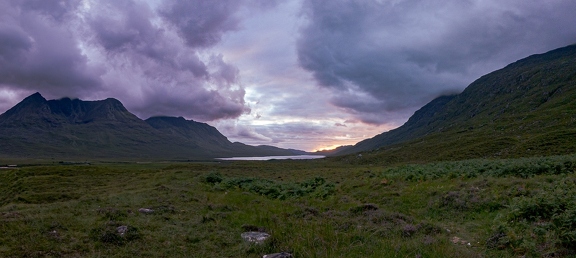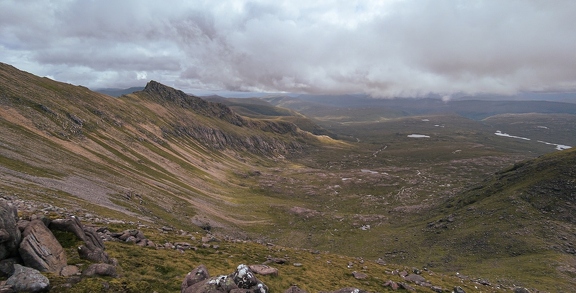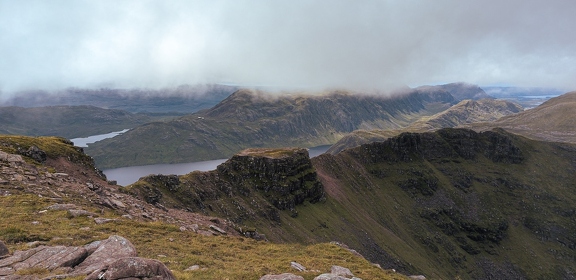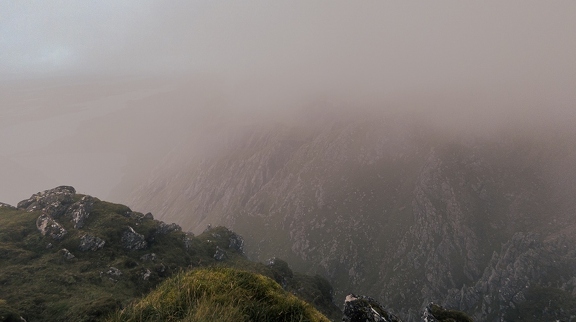I often find myself wondering why I climb hills, why I’m not prepared to enjoy normal holidays which involve pottering around pretty towns, lying on the beach, or visiting theme parks. I think my experiences of almost two weeks far north of the Great Glen, in the hills vaguely close to Ullapool, helped to answer that question for me: it’s clearly a feeling of achievement, of going somewhere only a tiny fraction of the population will ever go. Why I insist on having this feeling of achievement while also walking through the driving rain, however, is still an open question. But in the hours I spent in Fisherfield, alleged to be Scotland’s only real wilderness, I asked myself this question many, many times.
~~~
After a run of big hill days I decided that I’d have something approaching a rest day, and spent the day pottering around Ullapool, where I’d been staying for the last week while climbing quite a lot of hills in the vicinity. The village was busy; a very large cruise ship had moored in the bay in the morning, and hundreds of its passengers were receiving tours, so trying to relax was slightly more complicated than I’d imagined! I picked up an old paperback copy of Terry Pratchett’s Moving Pictures however: I wanted some lightweight, and ultimately expendible entertainment for this evening, for the plan was to hike into Fisherfield Forest, and camp there, at the start of the route around the five Munros and one Corbett which make up one of Scotland’s most famous hill rounds. Just after 5pm it seemed like a good time to leave Ullapool, and in something of a panic, as I had no obvious meal plans, I picked up a chilled cheese and onion quiche in Tesco, and drove around to the small layby at Corrie Hallie where the walk-in would begin.
As I sat in the lay-by, eating my cold quiche a heavy rainshower drummed on the roof of the car. I elected to wait until it passed, preparing as much as I could in the car knowing full well that as soon as the rain passed the midges would swarm.
To enter Fisherfield you first need to cross an area of upland moor which climbs to almost 400m, first on a landrover track and then on a much rougher, eroded, and often muddy track which leads across the lower slopes of An Teallach, and is the route I’d followed back from that hill a few days earlier. Alternatively there’s an option of following the landrover track to its end; the path ends at Shenaval bothy, the track at the foot of the first mountain of the celebrated round I was here to walk. My plan was to head for the end of the track, camp in some trees, and then leave the area via the bothy path the next day.
The Fisherfield Six, a round of five Munros, has a celebrated reputation for its difficulty, mostly as a result of this isolation. The mountains are undoubtedly amongst the hardest to reach, and potentially the furthest from the nearest road (though I think Seana Bhraigh and Ben Alder both have reasonable claim to this as well, not to mention Beinn a’ Mheadhoin in the Cairngorms which requires you to climb over a 4,000-foot mountain just to access it).
A couple of kilometres into my walk-in I bumped into a man on the track who asked if I was headed to the bothy; he said he’d left a woman there “who was in a bad way”. Somehow I interpreted this as meaning that she was injured, and out of concern I changed my plans as I figured someone alone and injured should probably be kept an eye on. He also told me that he’d managed to get a message out to her boyfriend, and I supposed I could pass along this reassurance. On a more selfish level the notion of the bothy not being incredibly busy also appealed, and it seemed a more likely source of a good night’s sleep than wildcamping.
The 8km walk into the bothy was painfully slow, and the final stretch of the path is very steep and eroded. As I finally caught sight of the building, (the path drops steeply down above it, it’s only visible for a short time before you reach it) I saw a figure walking around outside; either the hiker was not injured that badly, or there was now someone else.

I arrived to find it was the latter – both the people had already retreated upstairs and I checked if one of them was injured. This prompted some confusion, and they told me that no, neither of them were injured… After a slightly awkward exchange it transpired that the walker was not injured at all but she had come a cropper of the rising water levels where she had camped the previous night and become drenched. There was also a second man who I had observed outside a while earlier. I sat up for a time to read the bothy book (relatively tame, but new since June so perhaps hadn’t had a chance yet to become unhinged).
I slept quite well, but woke at six feeling tired and sore still. The woman who had been in difficulty had left shortly after dawn, and as I was trying to wake-up I filled in the bothy book and had my slightly depressing breakfast of two nutella-filled breakfast biscuit-things which did little to satisfy. It was raining as I put my tent and sleeping gear carefully stowed in a corner of the bothy to return for later. I wasn’t sure whether the ability to carry a couple of kilos less weight would balance the fact that my change of plans necessitated a cross-country walk (fortunately often with a path) across to the start point for climbing the first hill of the round. This was a Corbett, and the sixth hill of the Fisherfield Six. It had in fact been a Munro until 2012, when it was carefully remeasured and demoted. The walk was a trudge – the ground was sodden and I had to avoid a herd of cows. By the time I reached the river crossing I was already feeling slightly fed-up.
It’s safe to say that one of the things this route is most famous for are its three river crossings. One at the start of the day, and two at the end. While it had been a wet summer, there had been no heavy rain all week, but there had been plenty of less-heavy rain, so I was a bit apprehensive. The worst crossing I’d been forced to do before today was the shin-deep crossing at Geldie Lodge in the Cairngorms. This was to be at least knee-deep.
I changed into the crocs I had brought for the purpose; the crossing was not, as it turned out, all that bad, only ever reaching my knees. However as I reached the far bank it suddenly occurred to me that my shorts pockets contained both my phone and car keys. One getting soaked would have been annoying and left me without the Sherlock Holmes audiobook to keep me somewhat sane on the walk, the other could have left me stranded at the end of a very, very long day.
The climb up the heathery and pathless slope of Beinn a’ Chlaidheimh was slow and energy-sapping, and I was surprised to discover it was well after 10am by the time I summited, and this wasn’t even the first Munro! The cloud was hanging around the higher tops, and the strong wind was bringing in fairly frequent showers, so with no view there wasn’t much incentive to hang around. Rough boulderfields have been something of a feature in this trip, and the descent to the bealach with Sgùrr Bàn was not one to buck the trend. I did, at least, gain my first high-level views in exchange for dropping quite a bit of height.
The next climb took me back into cloud and into boulderfield after traversing the large bealach, and there was little to make the climb standout. Five hours after setting out I finally had my first Munro of the day.
As I descended the cloud had started to lift, giving me sight of the great scree-covered cone of the highest of the day’s summits, Mullach Coire Mhic Fhearchair. Fortunately it also revealed a winding path through it. While steep this path made for quick progress, and just 30 minutes after the first Munro I had my second.

There were then more boulders to contend with as I descended towards the clear path which would contour around Meall Garbh. Things finally started to feel like they were on track, and the weather was improving. Cloud was now blowing in and out, and often exposing vistas that I’d have appreciated in the earlier stages of the hike! After contouring round I then had the final climb up to Beinn Tarsuinn, the third Munro, up a fairly kind grassy slope. At the summit which sits on a platform which slants slightly towards the west I had the view of the next part of the ridge, including the famous “tennis court”.

This traverse was positively pleasant, before dropping down, across more boulders, to an extensive and boggy bealach which once again drained my energy and morale, before heading to a steep and unwelcome grassy slope.
It took two hours from Beinn Tarsuinn around to A’Mhaighdean, reputed to be Britain’s most remote summit, and it certainly felt like it! The top was in cloud, though I got patchy views through it and across to Slioch, and back over the route I’d walked.

The final Munro was close-by and was another steep cone which would prove a quick climb, and finally I had completed the Fisherfield 6. However I was still almost 20km from the car. Dropping off the Munro I had a long, boggy, and bouldery traverse over the shoulder of the hill before meeting the path from Poolewe which would take me down to the bothy at Larachantivore. Here I had my second river crossing of the day, which went smoothly, though I then had to negotiate waist high grass and boggy ground in order to meet my second crossing. The cows had returned, and my best option to avoid them took me straight into a thick stand of whin.
The crossing itself was fine, but the whin was fairly hard to push through, and the only line which avoided the cattle then saw me cross an area which appeared to be grass but turned out to be little patches of very long grass standing in knee-high water. Falling over several times I resigned myself to wading through this, energy exhausted by the bothy.
I collected my things, resolving the confusion of the new dwellers, who had seen the neat pile of things and wondered what sort of person forgets their tent, sleeping-bag, and paperback novel. Then I headed up the hill as fast as I could to avoid the midges which were taking advantage of the wind having completely dropped. The walk out was long and demoralizing, and I returned to the car at 10pm, hours later than planned, and feeling broken.
I then had the drive through the dark to Cannich, including two emergency stops: one for deer and one for a pine marten (my first sighting!)